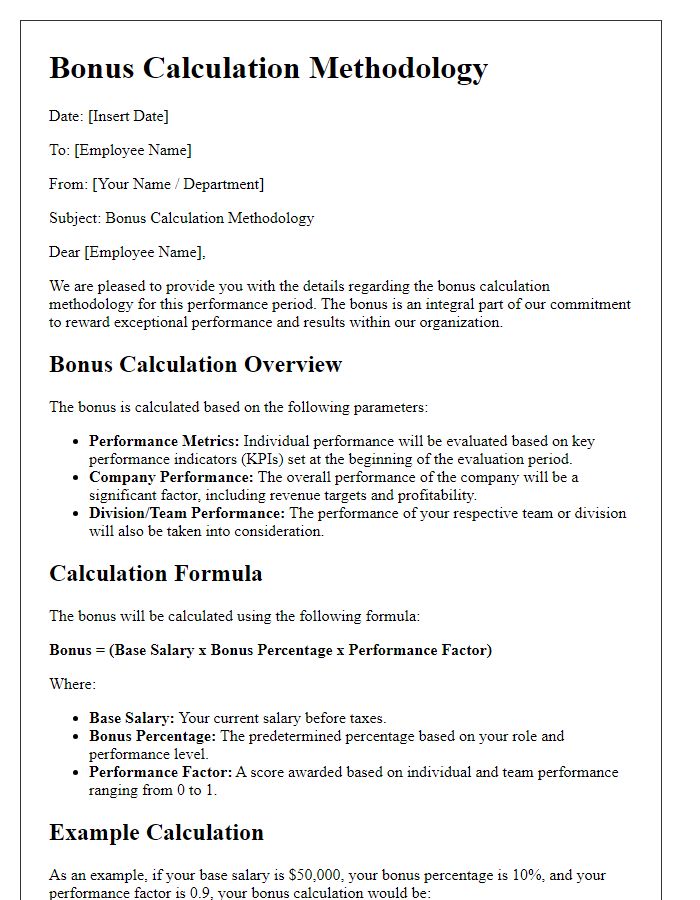Hey there! If you've ever wondered how bonus structures work within your organization, you're not alone. Understanding these financial incentives can truly enhance your motivation and performance at work. In this article, we'll break down the key components of a bonus structure, explaining how it's calculated and what you can do to maximize your potential earnings. So, stick around as we unveil the details and help you navigate the world of bonuses!

Introduction and Objective.
The bonus structure designed for employees at XYZ Corporation is aimed at incentivizing performance and fostering a culture of excellence. This structure primarily focuses on quantifiable metrics such as sales targets, project completion rates, and customer satisfaction scores. By clearly defining objectives, employees at all levels are encouraged to align their individual goals with the broader organizational goals, which ultimately drives success. Furthermore, the bonus program takes into account both individual contributions and team dynamics, ensuring that collaboration is rewarded alongside personal achievements. The transparent distribution of bonuses not only motivates employees but also cultivates loyalty and commitment to XYZ Corporation's mission and vision.
Criteria for Eligibility.
The bonus structure in many organizations often hinges on specific criteria that determine eligibility for employees. Key performance indicators (KPIs), such as sales targets (for instance, achieving 120% of quarterly sales goals), customer satisfaction scores (maintaining a minimum score of 90% on customer feedback surveys), and individual performance reviews (scored by supervisors at least 4 out of 5 during annual evaluations), serve as critical benchmarks. Length of service may also play a role, with employees typically required to have completed one full year at the company to qualify. Additionally, adherence to company values, demonstrated through participation in team projects or community service initiatives, enhances an employee's position within the bonus eligibility framework. Organizations may further stipulate that eligibility is contingent upon the company's overall financial health, such as achieving a minimum profit margin of 15%, thereby aligning individual performance with organizational success.
Calculation Methodology.
The bonus structure for employees at our company is designed to reward exceptional performance based on clearly defined metrics. For the fiscal year 2023, the methodology includes a base percentage of annual salary (typically ranging from 5% to 20%), determined by individual performance evaluations which utilize a scoring system from 1 to 5, with 5 being outstanding. Key performance indicators (KPIs) such as quarterly sales figures, customer satisfaction ratings, and project completion timelines contribute to these evaluations. In addition, team performance can influence the bonus pool, promoting collaboration among colleagues. Exceptional cases may warrant discretionary bonuses, which are subject to management approval. The calculation occurs annually, after the completion of the performance review cycle in December, with bonuses distributed in January, directly impacting employee motivation and financial wellbeing.
Payment Schedule.
A well-defined payment schedule outlines the timeline and conditions under which bonuses are awarded to employees. Bonuses may be structured based on performance metrics, typically calculated quarterly, biannually, or annually. For example, a quarterly bonus system may include evaluations in January, April, July, and October, assessing individual contributions aligned with company objectives. In contrast, an annual bonus might be determined at year-end, incorporating total project outcomes and overall profitability based on fiscal year data. Establishing clear criteria, such as sales targets, customer satisfaction scores, or completion of key performance indicators, ensures transparency and motivates employees. Specific bonus percentages, such as 10%-20% of base salary, are often mentioned to align expectations. Additionally, timing of the payment, often seen in December for annual bonuses, provides an incentive for continued performance throughout the year, rewarding employees for their contributions to the company's success.
Contact Information for Inquiries.
The bonus structure for employees at XYZ Corporation, established in 2023, outlines monetary rewards tied to key performance indicators (KPIs) such as revenue growth, individual achievements, and team performance metrics. Employees in the sales department, for example, may see bonuses ranging from 5% to 25% of their annual salary based on quarterly targets met. Additionally, management roles may require larger departmental goals, resulting in potential bonuses of up to 30% for successful project completions. Geographic locations, such as our New York headquarters and remote offices in San Francisco, might also impact bonus calculations due to varying cost of living adjustments. For further clarification or inquiries regarding this bonus structure, employees can reach out to the Human Resources team via internal email or the company portal.













Comments